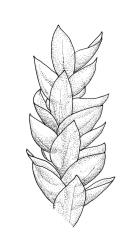The following generic description draws on Buck (1998) and Hedenäs (2002).
Plants medium-sized to robust, variable in colour, ± lustrous, forming mats on damp or irrigated rock, sometimes floating. Stems variably branched, in cross-section with several layers of thick-walled cells surrounding thin-walled cells and a distinct central strand. Stem and branch leaves not differentiated except by size, erect to erect-spreading, sometimes homomallous or weakly secund, often contorted or striolate when dry, broadly ovate to oblong-ovate, acute to broadly obtuse, weakly concave, not decurrent, margins plane, denticulate in upper half or to base; mid laminal cells linear or long-hexagonal, smooth or weakly prorate, thin- or firm-walled, not porose; apical cells and upper marginal cells shorter and more rhombic; alar cells mostly differentiated and enlarged (but scarcely so in N.Z. species). Costa single, rather slender and tapered to apex, with or without a terminal abaxial spine. Paraphyllia lacking. Pseudoparaphyllia foliose.
Autoicous. Perichaetia scattered on stems, often inconspicuous. Setae elongate, smooth or rarely scabrose (as in N.Z. species), mostly flexuose, orange- to red-brown or dark brown; capsules curved and asymmetric, broadly obovoid to short-cylindric, inclined to horizontal; exothecial cells subquadrate to short-rectangular to oblong, thin- or thick- walled, sometimes ± collenchymatous; stomata few at capsule base, round-pored; annulus differentiated or not; operculum rostrate from a conic base. Peristome perfect; exostome teeth dark yellow-brown; endostomal cilia short or well-developed, usually nodose. Calyptra cucullate & smooth. Spores smooth or finely papillose.
In modern floras Platyhypnidium is often included within a broadly defined Rhynchostegium (e.g., McFarland 1994). Although a relatively broad concept of Rhynchostegium is presented here, the aquatic habitat and the consistently broader and non-acuminate leaves with rhombic apical cells seem sufficient reason for retention of the two genera. Historically, Platyhypnidium has often been confounded with the southern hemisphere amblystegiaceous genus Hygrohypnum.
Platyhypnidium “was described to include 17 species” (Buck 1998, p. 248) and occurs primarily in temperate and high-elevation tropical regions.
Ignatov et al. (1999, p. 60) summarised the nomenclatural confusion surrounding the name Platyhypnidium. He supported Buck’s (1998) selection of the Javan P. muelleri as the generitype, noting that the Javan P. muelleri was the only species discussed in detail by Fleischer (1923). The recognition of P. muelleri (A.Jaeger) M.Fleisch. as the generitype helps clarify the application of this generic name. However, this typification is not accepted in Tropicos (data seen online, TROPICOS, accessed 19 June 2018) where the generitype is designated as the northern hemisphere P. rusciforme M.Fleisch. (usually considered a synonym of P. riparioides (Hedw.) Dixon). The nomenclatural issues surrounding Platyhypnidium and its included species are considerable and exceed the ambit of this eFlora.
North American authors (e.g. Crum & Anderson 1981) have often included species of Platyhypnidium (e.g., P. riparioides) in a broadly defined Eurhynchium. I agree with Buck 1998 that Platyhypnidium is given meaning by its aquatic habitat, non-differentiated stem, and branch leaves with broad apices, and by relatively slender and tapered costae. The concept of Platyhypnidium presented here conforms to those presented in recent revisions of the Brachytheciaceae for Australia (Hedenäs 2002) and the Huon Peninsula of P.N.G. (Ignatov et al. 1999).
Platyhypnidium austrinum, the only species of the genus in N.Z., is unusual in the genus by having scabrose setae. However, other brachytheciaceous genera have species with smooth and scabrous setae, and this difference is not sufficient reason to exclude P. austrinum from the present genus. Platyhypnidium aquaticum (A.Jaeger) M.Fleisch. is a species of tropical affinities that has been recorded from N.S.W. by Hedenäs (2012). According to his key, it has more obtuse leaves than the N.Z. species, and smooth setae.
| Category | Number |
|---|---|
| Indigenous (Non-endemic) | 1 |
| Total | 1 |




